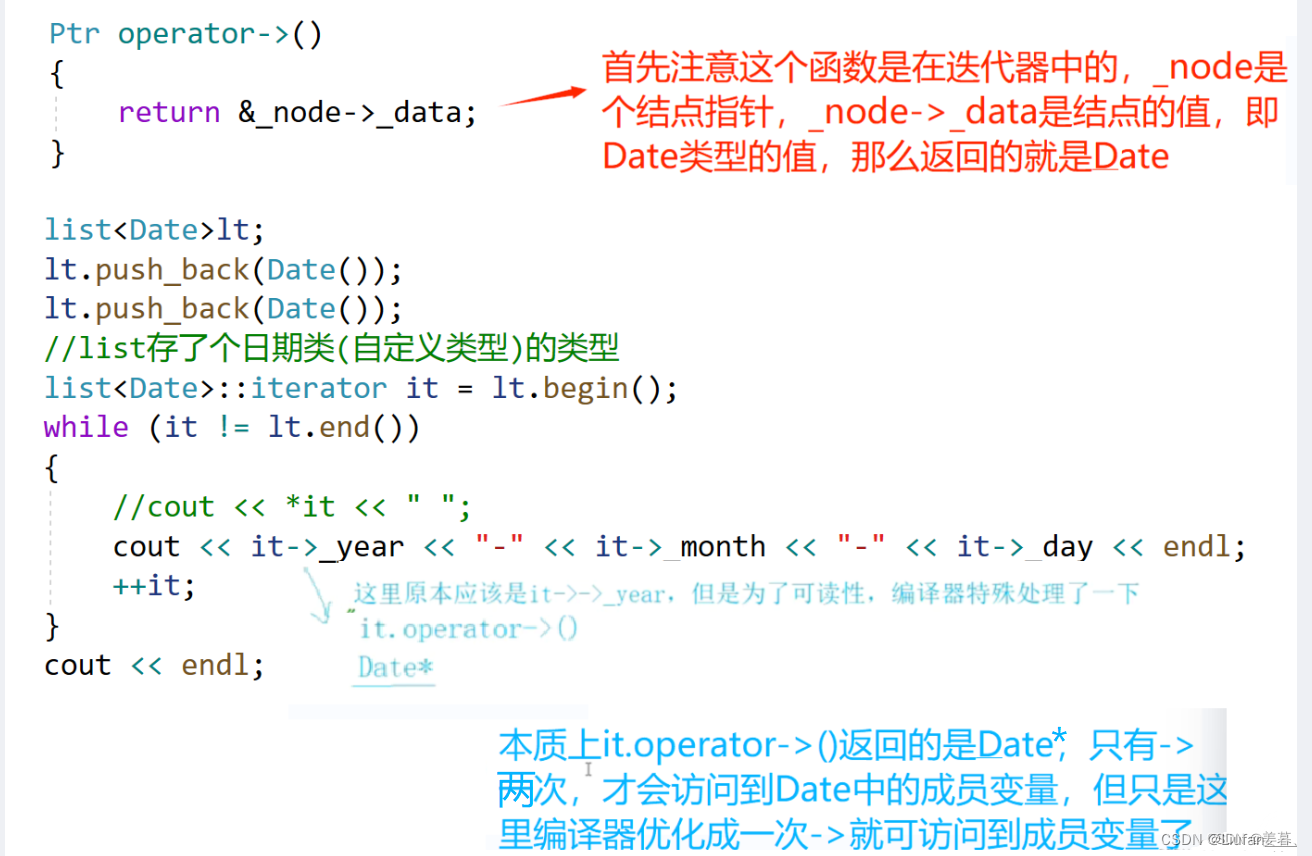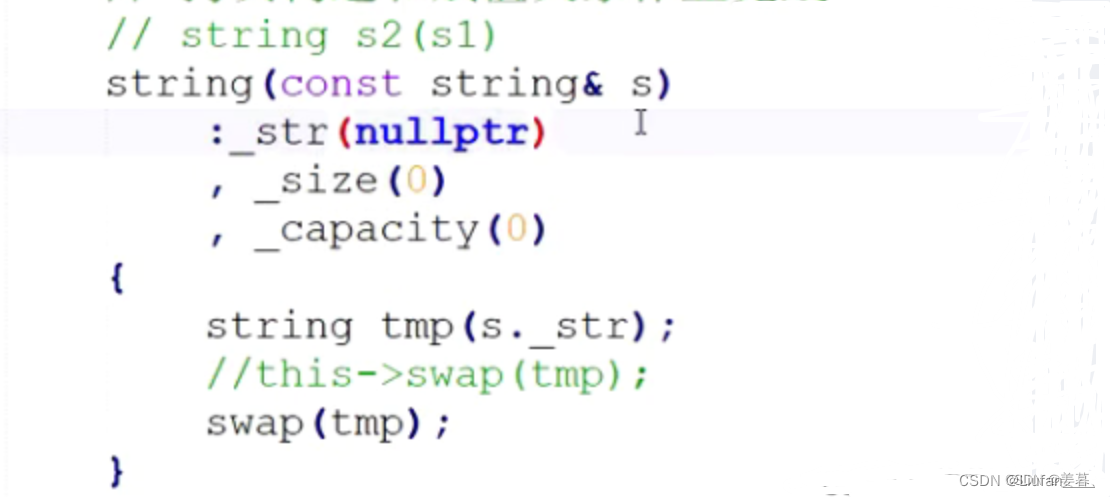一、list的概念引入
1.vector与list的对比
为什么会有list?
补充vector的缺点存在的
vector缺点:
1.头部和中部的插入删除效率低,O(N)因为需要挪动数据。
2.插入数据空间不够需要增容。增容需要开新空间、拷贝数据、会付出很大的代价。
优点:
1、支持下标的随机访问。间接的就很好的支持排序、二分查找、堆算法等等。
list出厂就是为了解决vector的缺陷
优点:
1.list头部、中间插入不再需要挪动数据,效率高。O(1)
2.list插入数据是新增节点,不需要增容
缺点:
不支持随机访问。
2.关于struct和class的使用
C++中的struct和class的唯一区别在于默认访问权限(即你不写public、private这种访问限定符)不同,struct默认为共有(public),而class默认为私有(private),一般情况,成员部分私有,部分公有,就用class,所有成员都开放或共有,就用struct
所以下文写的节点和迭代器类都用struct是因为,struct中的成员函数都默认为公有理,也不用写public了,但是你用class就要写个public
3.list的迭代器失效问题
list本质:带头双向循环链表
支持操作接口的角度分迭代器的类型:单向(forward_list)、双向(list)、随机(vector)
从使用场景的角度分迭代器的类型:(正向迭代器、反向迭代器)+const迭代器
二、list的模拟实现
1.list三个基本函数类
list本质是一个带头双向循环链表:
模拟实现list,要实现下列三个类
-
模拟实现结点类
-
模拟实现迭代器的类
-
模拟实现list主要功能的类
list的类的模拟实现其基本功能(增删等操作)要建立在迭代器类和节点类均已实现好的情况下才得以完成。
2.list的结点类实现
因为list的本质为带头双向循环链表,所以其每个结点都要确保有下列成员:
1.前驱指针
2.后继指针
3.data值存放数据
而结点类的内部只需要实现一个构造函数即可。
cpp
template<class T>
struct _list_node
{
listnode<T>* _next;
listnode<T>* _prev;
T _data;
listnode(const T& val=T())
:_next(nullptr)
,_prev(nullptr)
,_data(val)
{}
};为什么是_list_node<T>?
首先,C++中用struct定义是可不加struct,重点是这里用了一个类模板,类模板的类名不是真正的类型且类模板不支持自动推类型,即_list_node不是真正的类型,定义变量时,_list_node<T>这种才是真正的类型,也就是用类模板定义变量时必须指定对应的类型。
注:结构体模板或类模板在定义时可不加<T>,但使用时必须加<T>。
3.list的迭代器类的实现
因为list其本质就是带头双向循环链表,而链表的物理空间是不连续的,是通过结点的指针顺次链接,我们不能向先前的string和vector一样直接解引用还是结点,结点指针++还是结点指针,而string和vector的物理空间是连续的,所以这俩不需要实现迭代器类,可以直接使用。
为了能让list像vector一样接应用后访问对应节点中的值,++访问到下一个数据,我们需要单独写一个迭代器类的接口实现,在其内部进行封装补齐相应的功能,而这就要借助运算符重载来完成。
注:迭代器封装后是想模拟指针的行为
3.1 基本框架
cpp
template<class T,class Ref,class Ptr>
struct _list_iterator
{
typedef _list_node<T> Node;
typedef _list_iterator<T, Ref, Ptr>Self;
Node* _node;
};1)迭代器类模板为什么要三个参数?
若只有普通迭代器的话,一个class T参数就够了,但因为有const迭代器原因,需要加两个参数,两个参数明Ref(reference:引用)和Ptr(pointer:指针),名字怎么起都行,但这种有意义的名字很推荐的,即这两个参数一个让你传引用,一个让你传指针,具体等到下文讲到const迭代器再说
2)迭代器类到底是什么?
迭代器类就是一个结点的指针变量_node,但是因为我们要运算符重载等一些列操作,不得不把迭代器写成类,完成哪些操作,list的迭代器才能正确的++到下一个位置,解引用访问节点的值。
3)结点指针和迭代器的区别?

当他们都指向同一个结点,那么在物理内存中他们都存的是这个结点地址,物理上是一样的,但是他们的类型不一样,他们的意义就不一样。比如*cur是一个指针的解引用,取到的值是结点;*it是去调用迭代器中" * "的运算符重载operator*,返回值是结点中存的值。
类型决定了对空间的解释权
3.2 构造函数
cpp
_list_iterator(Node* node)
:_node(node)
{}3.3 operator*
cpp
Ref operator*()
{
return _node->_data;
}1)返回值为什么是Ref?
Ref是模板参数,因为迭代器类的模板参数Ref传入的要么是T&,要么是const T&,就是为了const迭代器和普通迭代器的同时实现,底层就是这么实现的,意义就是一个只读,一个可读可写
注:比如之前讲的vector的迭代器,*it(假设it是迭代器变量)就是拿到对应的值,那么list的迭代器也要同理,解引用迭代器就是为了访问对应位置的值,那么list只要通过迭代器返回对应结点的值就好了。
3.4 operator->
cpp
Ptr operator->()
{
return &_node->_data;
}1)为什么需要operator->?
本质因为自定义类型需要,那需从list存的类型是个自定义类型说起,以Date类说明。若list存了个自定义类型的Date类,就无法打印,因为我们并没有重载Date类的operator<<,若是内置类型的话才可以正常输出,那写一个operator<<重载吗?不,因为你无法确定要用那些类,也不能每个类都写operator<<,怎么半?我们访问Date类本质是想访问它内置类型(int)的_year,_month,_day吧,那我们不妨写个专属于自定义类型的operator-> (因为内置类型只需要*it就可以直接输出了,但自定义类型不可以直接输出),利用operator->直接访问类的成员变量,而内置类型可以直接输出
**故从根源上解决问题:**在迭代器中实现个operator->:
(Ptr是迭代器的模板参数,我们用来作为T*或const T*的)

3.5 operator前置++和后置++和--
cpp
Self& operator++()
{
_node = _node->_next;
return *this;
}
Self operator++(int)
{
Self tmp(*this);
_node = _node->_next;
return tmp;
}
Self& operator--()
{
_node = _node->_prev;
return *this;
}
Self operator--(int)
{
Self tmp(*this);
_node = _node->_prev;
return tmp;
}1)迭代器++对于list是什么意思?
迭代器++的意思就是想让其指向下一个节点,--正好相反,为了区分前置和后置++(--),我们会用函数重载,也就是多一个"没用的"参数:int,这个参数没什么用,只是为了区分++和--
3.6 operator==与operator!=
cpp
bool operator!=(const Self& it)
{
return _node != it._node;
}
bool operator==(const Self& it)
{
return _node == it._node;
}两个迭代器怎么比较的?
迭代器中就一个成员变量_node,结点指针,只要比较当前结点指针是否相同即可,这个操作在判断迭代器是否走到头有用。
问题:迭代器的拷贝构造、赋值和析构函数需要我们实现吗?
答:不需要
因为迭代器存的就是一个节点指针,而节点是属于链表list的,那么它的释放应有list来实现,那么迭代器的析构也无需我们自己写了。总而言之,迭代器并不涉及从堆上开空间,使用系统提供的浅拷贝就可以了。
4、list类的实现
在节点类和迭代器类都实现的前提下,就可实现list主要功能:增删等操作的实现
4.1 基本框架
cpp
template<class T>
class list
{
typedef _list_node<T> Node;
public:
typedef _list_iterator<T, T&, T*>iterator;
typedef _list_iterator<T, const T&, const T*> const_iterator;
private:
Node* _head;
};const_iterator(const迭代器的介绍)
我们知道const_iterator在begin()和end()中的返回值是需要用到的,其主要作用就是当迭代器只读时使用,因为普通迭代器和const迭代器的实现区别仅仅在于成员函数的返回值不同,难道重写一遍吗?不用,我们模板参数多两个就好了,一个是引用class Ref(T&或const T&),一个是指针class Ptr(T*或const T*),当Ref时const T&就是const迭代器的调用,这就利用模板实现了两个迭代器的同时实现。
4.2 构造函数
cpp
list()
{
_head = new Node;
_Head->_next = _head;
_head->_prev = _head;
}我们开辟一个头结点,然后使其处于一个对应的初始状态即可。
4.3 begin()和end()
cpp
iterator begin()
{ //第一个位置应该是头节点的下一个节点
return iterator(head->_next);//用匿名对象构造iterator类型的
}
iterator end()
{
return iterator(_head);
}
const_iterator begin()const
{
return const_iterator(head->next);
}
const_iterator end()const
{
return const_iterator(_head);
}1)关于匿名构造的理解
比如iterator(_head->next);iterator是一个类模板类型(它被typedef过),那不应该实例化一个对象再构造吗?这里没有用是因为这里是匿名对象的构造,这里这么用比较方便。
4.4拷贝构造
cpp
list(const list<T>& It)
{
_head = new Node;
_head->_next = _head;
_head->_prev = _head;
for (auto e : lt)
{
push_back(e);
}
}**解释:**list的拷贝构造跟vector不同,它的拷贝是拷贝一个个节点(因为不连续的物理空间),那么我们可以用迭代器拿到list的一个个节点【上面是传统写法】
现代写法:
cpp
template<class Inputerator>
list(Inputerator first, Inputerator last)
{
_pHead = new Node();
_pHead->next = _pHead;
_pHead->prev = _pHead;
while (first != last)
{
push_back(*first);
first++;
}
}
//拷贝构造(现代写法)
list(const list<T>& L)
{
_pHead = new Node();
_pHead->next = _pHead;
_pHead->prev = _pHead;
list<T> tmp(L.begin(), L.end());
swap(_pHead, tmp._pHead);
}1)为什么有的拷贝构造需要初始化,operator=不需要?
以string 的模板实现为例

4.5 clear
cpp
void clear()
{
iterator it = begin();
while (it != end())
{
it = erase(it);
}
}1) it=erase(it)什么意思
防止迭代器失效,因为erase返回的是被删除位置的下一个位置,比如删除pos位置的,pos位置被删除后,这个位置的迭代器就失效了,那就无法通过++找到后面的位置了,所以我们通过erase返回值来更新一下迭代器位置,即更新到被删除位置的下一个位置
4.6 operator=
cpp
list<T>& operator=(list<T> lt)
{
swap(_head, lt._head);
return *this;
}4.7 析构函数
cpp
~list()
{
clear();
delete _head;
_head = nullptr;
}4.8 insert
cpp
iterator insert(iterator pos, const T& x)
{
Node* newnode = new Node(x);
//找到pos位置的指针和pos之前的指针
Node* cur = pos._node;
Node* prev = cur->_prev;
//prev newnode cur
prev->_next = newnode;
newnode->_prev = prev;
newnode->_next = cur;
cur->_prev = newnode;
//返回新插入元素的迭代器位置
return iterator(newnode);
}1)返回参数为什么是iterator?
本质是为了防止迭代器失效问题
**注:**insert指的是插入到指定位置的前面
4.9 push_back和push_front
cpp
void push_back(const T& x)
{
Node* tail = head->prev;
Node* newnode = new Node(x);
tail->_next = newnode;
newnode->_prev = tail;
newnode->_next = _head;
_head->_prev = newnode;
}4.10 erase
cpp
iterator erase(iterator pos)
{
assert(pos != end())
{
Node* cur = pos._node;
Node* prev = cur->_prev;
NOde* next = cur->_next;
prev->_next = next;
next->_prev = prev;
delete cur;
return iterator(next);
}
}返回值问题
erase的返回值,返回的是被删除位置的下一个位置,库里面这么规定,本质是因为删除元素一定会导致此位置的迭代器失效,故返回被删除位置的下一个位置可以更新迭代器
4.11pop_back和pop_front
cpp
void pop_back()
{
erase(--end());
}
void pop_front()
{
erase(begin());
}三、源代码
cpp
#pragma once
#include <iostream>
using namespace std;
namespace lf
{
template <class T>
struct listNode
{
T Data;
listNode<T>* _next;
listNode<T>* _prev;
listNode(const T& val = T())
:Data(val)
,_next(nullptr)
,_prev(nullptr)
{}
};
template <class T,class Ref,class Ptr>
struct list_Iterator
{
typedef listNode<T> node;
typedef list_Iterator<T, Ref, Ptr> Self;
node* _node;
list_Iterator(node* node)
:_node(node)
{}
Ref operator*()
{
return _node->Data;
}
Ptr operator->()
{
return &_node->Data;
}
Self operator++()
{
_node = _node->_next;
return *this;
}
Self operator++(int)
{
Self tmp(*this);
_node = _node->_next;
return tmp;
}
Self operator--()
{
_node = _node->_prev;
return *this;
}
Self operator--(int)
{
Self tmp(*this);
_node = _node->_prev;
return tmp;
}
bool operator!=(const Self& it)const
{
return _node != it._node;
}
bool operator==(const Self& it)const
{
return _node == it._node;
}
};
template <class T>
class list
{
typedef listNode<T> node;
public:
typedef list_Iterator<T, T&, T*> iterator;
typedef list_Iterator<T, const T&, const T*> const_iterator;
iterator begin()
{
return iterator(_head->_next);
}
iterator end()
{
return iterator(_head);
}
const_iterator begin() const
{
return const_iterator(_head->_next);
}
const_iterator end() const
{
return const_iterator(_head);
}
void empty_init()
{
_head = new node;
_head->_next = _head;
_head->_prev = _head;
}
list()
{
empty_init();
}
list(const list<T>& lt)
{
empty_init();
for (auto e : lt)
{
push_back(e);
}
}
~list()
{
clear();
delete _head;
_head = nullptr;
}
list<T>& operator=(list<T> lt)
{
swap(_head, lt._head);
return *this;
}
void clear()
{
iterator it = begin();
while (it != end())
{
it = erase(it);
}
}
// prev head next 2 head 1
iterator erase(iterator pos)
{
node* cur = pos._node;
node* prev = cur->_prev;
node* next = cur->_next;
prev->_next = next;
next->_prev = prev;
delete cur;
cur = nullptr;
return iterator(next);
}
// 1 2 newnode head
void insert(iterator pos,const T& val)
{
node* newnode = new node(val);
node* cur = pos._node;
node* prev = cur->_prev;
newnode->_next = cur;
cur->_prev = newnode;
prev->_next = newnode;
newnode->_prev = prev;
}
void push_back(T val)
{
insert(end(), val);
}
void pop_back()
{
erase(--end());
}
private:
node* _head;
};
void test_list1()
{
list<int> lt1;
list<int>::iterator it = lt1.begin();
lt1.insert(it, 1);
lt1.push_back(2);
lt1.push_back(3);
//lt1.pop_back();
list<int>::iterator it1 = lt1.end();
//lt1.erase(--it1);
/*for (auto _begin = lt1.begin(), _end = lt1.end(); _begin != _end; ++_begin)
{
cout << *_begin << " ";
}*/
lt1.clear();
for (auto e : lt1)
{
cout << e << " ";
}
//cout << *it << endl;
}
void test_list2()
{
list<int> lt;
lt.push_back(1);
lt.push_back(2);
lt.push_back(3);
list<int> lt1(lt);
lt.push_back(4);
lt.push_back(5);
lt.push_back(6);
lt.push_back(7);
lt1 = lt;
lt.operator=(lt1);
for (auto e : lt)
{
cout << e << " ";
}
cout << endl;
for (auto e : lt1)
{
cout << e << " ";
}
cout << endl;
}
};